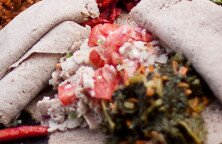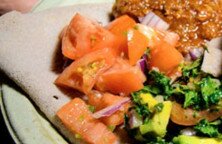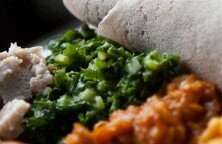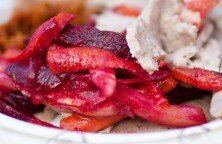Injera
2013-04-10Injera is fermented Ethiopian teff flour-based flatbread. Making injera from scratch takes patience more than anything. The recipe is simple, but the fermenting process requires care and handling. While in Ethiopia injera is usually made with 100% gluten-free teff flour (available at natural food stores and Whole Foods), it is more difficult in New York because teff flour is expensive and the low altitude makes the fermentation process less effective. Thus injera in the northwest US is commonly made with a combination of teff flour and whole wheat or barley flour. Below is a basic recipe for injera with teff and barley flour.
Note: This is a basic recipe that may require some adjustment to obtain the texture and taste you desire. Let us know if we can help.
In NYC, injera can be purchased online at zelaleminjera.com, or by contacting Bunna Café at . Purchased in bulk, the bread usually lasts 4-5 days refrigerated (if wrapped tightly), or a few weeks if frozen.
Ethiopian food is served as multiple dishes in one large platter. These recipes are for a full shared platter for four people. The dishes are served on top of one large piece of injera rolled out and laid flat on the platter. The dishes are spooned on top of the injera in a clockwise fashion, making sure there are small portions of each dish on each side so they are easily attainable by all guests. Finally, additional injera is rolled up, split into thirds, and served on a separate plate. This serves as a utensil for the guests.
Ingredients
- 1/2 cup teff flour
- 1/2 cup whole wheat flour or barley flour*
- 1 cup water
- a pinch of salt
- cooking oil
Method
Step 1
Put the teff flour in the bottom of a mixing bowl, and sift in the wheat or barley flour. Slowly add the water, stirring to avoid lumps. Put the batter aside for a day or more (up to three days) to allow it to ferment. In this time, your injera batter will start to bubble and acquire the slight tanginess for which it’s known. Stir in the salt.
Step 2
Heat a nonstick pan or lightly oiled flat cast-iron skillet or a crepe pan until a water drop dances on the surface. Make sure the surface of the pan is smooth: Otherwise, your injera might fall apart when you try to remove it. Coat the pan with a thin layer of batter. Injera should be thicker than a crêpe, but not as thick as a traditional pancake. It will rise slightly when it heats. No need to flip, cook on one side until the top is solid and pockmarked.
* You can experiment by adjusting the ratios of wheat and teff flours in your recipe, or by adding another type of flour altogether. You can also let your batter ferment for more or less time, depending on how sour you like your injera to be.
Recipe courtesy of Bunna Cafe.
Average Member Rating
(5 / 5)
1 people rated this recipe















